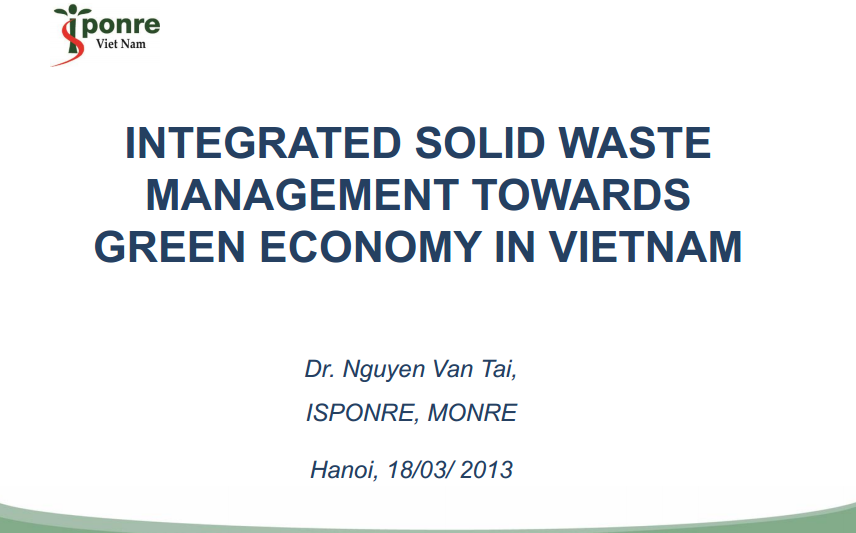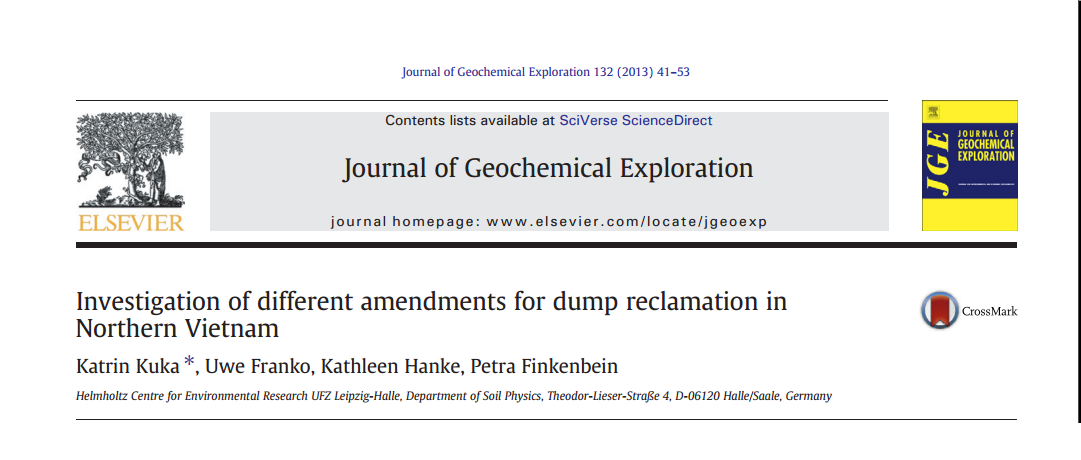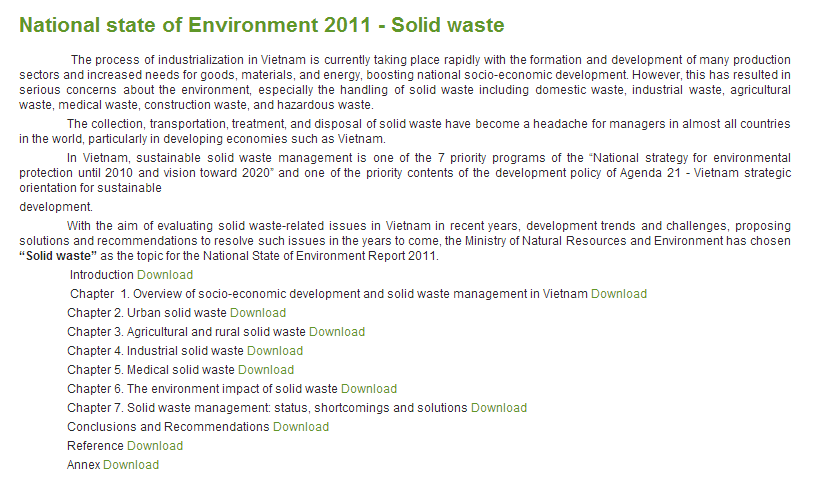REPORTS & PUBLICATION
REPORTS
GUIDELINES FOR NATIONAL WASTE MANAGEMENT STRATEGIES: MOVING FROM CHALLENGES TO OPPORTUNITIES
2013 | United Nations Environment Programme
The statistics are stark: 3.5 billion people, or half of the world population, are without access to waste management services, and open dumping remains the prevalent waste-disposal method in most low- and lower middle- Income countries. More than 1.3 billion tonnes of municipal solid waste were estimated to have been generated in 2012 and 2.2 billion tonnes a year are expected by 2025. Urbanization, industrialization, increasing population and economic development are all contributing to the rise in waste and also to its increasing complexity and hazardousness.
Country Analysis Paper
2013 | UNCRD
Rapid growth of economic urbanization and industrial development are the cause of more concerns within solid waste management. In this regard, the Ministry of Environment is the institution responsible for protecting the environment and human health has developed the guidelines as well as related orders to solve the problems and enhance environmental quality in Cambodia that include: the development of legal instruments and related regulations. Refer to annual report conducted by Department of Pollution Control, solid waste collection and disposal at dumping sites in cities and districts is about 933,144 tones with increasing rate amount 10\% every year.

INTEGRATED SOLID WASTE MANAGEMENT TOWARDS GREEN ECONOMY IN VIETNAM
2013 | Vietnam Ministry of resources and environment

Investigation of different amendments for dump reclamation in Northern Vietnam
2013 | Elsevier
Giant spoil dumps originate in the course of open-cast mining. The initial properties of Triassic spoil as well as pedogenesis are characterized by weathering processes. Due to the poor conditions in dump spoil a natural succession of plants or a re-vegetation is a lengthy process. The Chinh Bac field experiment (Ha Long City, Quang Ninh province, Vietnam) was planned to investigate the possible impacts of three amendments charred rice straw, power station ashes and fine material originating from the mining area in combination with sieved spoil of substrate quality to enhance plant growth. The main focus of this study was directed towards the impact of added amendments on spoil chemical parameters. The investigations demonstrated that simply sieving the spoil leads to better substrate conditions. It increases the fine material which in turn leads to easier plantation conditions. At the same time oxidative processes and leaching acid products are stimulated which raises the pH values afterwards.

National state of Environment 2011 - Solid waste
2013 | Centre For Environmental Monitoring Portal Vietnam Environment Administration
The process of industrialization in Vietnam is currently taking place rapidly with the formation and development of many production sectors and increased needs for goods, materials, and energy, boosting national socio-economic development. However, this has resulted in serious concerns about the environment, especially the handling of solid waste including domestic waste, industrial waste, agricultural waste, medical waste, construction waste, and hazardous waste. The collection, transportation, treatment, and disposal of solid waste have become a headache for managers in almost all countries in the world, particularly in developing economies such as Vietnam. In Vietnam, sustainable solid waste management is one of the 7 priority programs of the “National strategy for environmental protection until 2010 and vision toward 2020†and one of the priority contents of the development policy of Agenda 21 - Vietnam strategic orientation for sustainable development. With the aim of evaluating solid waste-related issues in Vietnam in recent years, development trends and challenges, proposing solutions and recommendations to resolve such issues in the years to come, the Ministry of Natural Resources and Environment has chosen“Solid wasteâ€Â as the topic for the National State of Environment Report 2011.
Review of past research and proposed action plan for landfill gas-to-energy applications in India
2013 | Sage
Open dumps employed for disposal of municipal solid waste (MSW) are generally referred to as landfills and have been traditionally used as the ultimate disposal method in India. The deposition of MSW in open dumps eventually leads to uncontrolled emission of landfill gas (LFG). This article reviews the MSW disposal practices and LFG emissions from landfills in India during the period 1994 to 2011. The worldwide trend of feasibility of LFG to energy recovery projects and recent studies in India indicate a changed perception of landfills as a source of energy. However, facilitating the implementation of LFG to energy involves a number of challenges in terms of technology, developing a standardized framework and availability of financial incentives. The legislative framework for promotion of LFG to energy projects in India has been reviewed and a comprehensive strategy and action plan for gainful LFG recovery is suggested. It is concluded that the market for LFG to energy projects is not mature in India. There are no on-ground case studies to demonstrate the feasibility of LFG to energy applications. Future research therefore should aim at LFG emission modeling studies at regional level and based on the results, pilot studies may be conducted for the potential sites in the country to establish LFG to energy recovery potential from these landfills.
 The kNOwWaste Knowledge Platform was developed through a Project Cooperation Agreement funding by UNEP on 2016. The platform provides data and information on holistic waste management to stakeholders in Asia and the Pacific region. The platform was developed with the following aims: generate and consolidate data or information on holistic waste management, transform data into easily comprehensible outputs for use by key stakeholders, map out and disseminate information on international waste management projects under the GPWM and UNEP projects as well as other international partners, and provide capacity building support through dissemination of data or information support for relevant stakeholders on holistic waste and waste management system.
The kNOwWaste Knowledge Platform was developed through a Project Cooperation Agreement funding by UNEP on 2016. The platform provides data and information on holistic waste management to stakeholders in Asia and the Pacific region. The platform was developed with the following aims: generate and consolidate data or information on holistic waste management, transform data into easily comprehensible outputs for use by key stakeholders, map out and disseminate information on international waste management projects under the GPWM and UNEP projects as well as other international partners, and provide capacity building support through dissemination of data or information support for relevant stakeholders on holistic waste and waste management system.
 2024 © Regional Resource Center for Asia and the Pacific (RRC.AP). All Rights Reserved.
2024 © Regional Resource Center for Asia and the Pacific (RRC.AP). All Rights Reserved.
